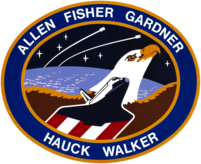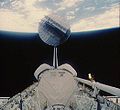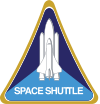STS-51-A
| Missionsemblem | |||||
|---|---|---|---|---|---|
 | |||||
| Missionsstatistik | |||||
| Missionsnavn: | STS-51-A | ||||
| Rumagentur: | NASA | ||||
| Rumfærge: | Discovery (7) | ||||
| Antal besætningsmedlemmer: | 5 | ||||
| Affyringsrampe: | LC-39A (KSC) | ||||
| Opsendelse: | 8. november 1984 | ||||
| Landing: | 16. november 1984 | ||||
| Landet på: | Kennedy Space Center | ||||
| Varighed: | 8 dage, 23 timer | ||||
| Foto af besætningen | |||||
 | |||||
| Navigation | |||||
| |||||
STS-51-A (Space Transportation System-51-A) var Discoverys syvende rumfærge-mission. Opsendt 8. november 1984 og vendte tilbage den 16. november 1984.
Missionens hovedformål var at sætte to kommunikationssatellitter Anik D2 og Leasat I i kredsløb og bringe to andre Palapa B-2 og Westar 6 tilbage til jorden.
Besætning

 Frederick Hauck (kaptajn)
Frederick Hauck (kaptajn)
 David M. Walker (pilot)
David M. Walker (pilot)
 Anna Fisher (1. missionsspecialist)
Anna Fisher (1. missionsspecialist)
 Dale Gardner (2. missionsspecialist)
Dale Gardner (2. missionsspecialist)
 Joseph Allen (3. missionsspecialist)
Joseph Allen (3. missionsspecialist)
Missionen
Hovedartikler:
Eksterne henvisninger
- STS-51-A NASA (engelsk)
| ||||||||
| ||||||||||||||||||||
Medier brugt på denne side
Astronaut Dale A. Gardner, having just completed the major portion of his second extravehicular activity (EVA) period in three days, holds up a "For Sale" sign refering to the two satellites, Palapa B-2 and Westar 6 that they retrieved from orbit after their Payload Assist Modules (PAM) failed to fire. Astronaut Joseph P. Allen IV, who also participated in the two EVAs, is reflected in Gardner's helmet visor. A portion of each of two recovered satellites is in the lower right corner, with Westar 6 nearer Discovery's aft.
View of the Syncom IV-1 satellite after deployment from STS-51-A.
In a frisbee-type method, the Syncom IV-1 satellite leaves the Discovery's payload bay on its way into service for the U.S. Navy. Retrieval hardware and part of the pallet for securing the Palapa B-2 are pictured near the protective shield for the now vacated Telest-H/PAM-B.
Forfatter/Opretter: By Rei-artur (diskussion · bidrag)., Licens: CC-BY-SA-3.0
Venus/female symbol.
View of the Westar 6 satellite while Dale Gardner retrieves it during STS-51-A.
- Astronaut Dale A. Gardner, wearing the manned maneuvering unit (MMU) approaching the spinng Westar VI satellite over Bahama Banks. Gardner uses a large tool called the apogee kick motor capture device (ACD) to enter the nozzle of the spent Westar engine and stabilize the satellite to capture it for return to Earth.
SVG version of PNG Space Shuttle Logo/Patch.
Forfatter/Opretter: Rei-artur (diskussion · bidrag), reshaped by F l a n k e r (talk), Licens: CC-BY-SA-3.0
symbol of Mars. 400 × 400 pixels nominal dimensions, line 45 pixel tick, circle 295 × 295 pixel, not joined with arrow. Colour: red=0 green=0 blue=140.
![]() Vektorgrafikken blev lavet med Inkscape.
Vektorgrafikken blev lavet med Inkscape.
Rotated and color enhanced version of original (ISS013-E-48788 (6 July 2006) --- The Space Shuttle Discovery approaches the International Space Station for docking but before the link-up occurred, the orbiter "posed" for a thorough series of inspection photos. Leonardo Multipurpose Logistics Module can be seen in the shuttle's cargo bay. Discovery docked at the station's Pressurized Mating Adapter 2 at 9:52 a.m. CDT, July 6, 2006.)
The crew assigned to the STS-51A mission included Frederick H. Hauck, commander,who is seated to the right. Standing, left to right, are Dale A. Gardner, mission specialist; David M. Walker, pilot; and mission specialists Anna L. Fisher, and Joseph P. Allen. Launched aboard the Space Shuttle Discovery on November 8, 1984 at 7:15:00 am (EST), the STS-51A mission deployed the Canadian communications satellite TELLESAT-H (ANIK), and the defense communications satellite SYCOM IV-1 (also known as LEASAT-1). In addition, 2 malfunctioning satellites were retrieved: the PALAPA-B2 and the WESTAR-VI.
STS-51A Mission Insignia
- The Space Shuttle Discovery en route to Earth orbit for NASA's 51-A mission is reminiscent of a soaring Eagle. The red and white trailing stripes and the blue background, along with the presence of the Eagle, generate memories of America's 208 year-old history and traditions. The two satellites orbiting the Earth backgrounded amidst a celestial scene are a universal representation of the versatility of the Space Shuttle. White lettering against the blue border lists the surnames of the five-member crew.














